HYDRAULICS
4181383 First Edition 6-37
6
2. Park the mower safely. (See “Park Mower Safely” on
page 1-5.)
3. Remove the center floorboard.
Figure 6-30
Figure 6-31
4. Install tee fitting between fitting (1) and hose (2).
5. Connect test hose from tee fitting to pressure gauge
(3).
6. Bypass seat switch.
!
CAUTION
7. Start engine and run at full throttle (3150 rpm ± 50).
8. Turn steering wheel fully right against stop.
9. Record pressure reading.
10. Stop engine.
Is lift/steer system relief pressure 1595 psi (110
bar)?
YES Lift/steer system relief valve is good.
Proceed to step 11.
NO Test lift/steer pump. (See “Lift/Steer Pump
Test” on page 6-39.) Test lift cylinder. (See
“Lift Cylinder Leakage Test” on page 6-21.)
Replace steering valve. (See “Steering
Valve” on page 7-7.)
11. Disconnect and remove test equipment. Install all
hoses and fittings as noted prior to removal.
12. Install and connect all components as noted prior to
test.
13. Check hydraulic oil level. Add oil as needed. (Refer to
“Safety, Operation, and Maintenance Manual” for
correct oil specifications.)
Lift System Test
See Figures 6-32 and 6-33.
!
WARNING
1. Park the mower safely. (See “Park Mower Safely” on
page 1-5.)
2. Remove the center floorboard.
Do not run mower lift/steer system relief valve
over relief longer than 10 seconds or damage
may occur to hydraulic system.
TN1395
1
2
TN1275
3
The hydraulic system is under pressure, and the
oil will be hot.
• Always relieve pressure in the hydraulic
system before performing service.
• Failure to follow appropriate safety
precautions may result in death or serious
injury.
Required Tools and Materials
• Flow Meter
• -8 ORFS Test Hose 2000 psi (138 bar)
• -8 ORFS Tee Fitting

